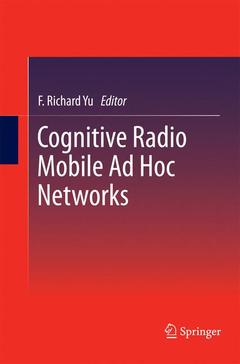Description
Cognitive Radio Mobile Ad Hoc Networks, 2011
Coordinator: Yu F. Richard
Language: English
Subject for Cognitive Radio Mobile Ad Hoc Networks:
Publication date: 10-2014
476 p. · 15.5x23.5 cm · Paperback
Publication date: 09-2011
476 p. · 15.5x23.5 cm · Hardback
Description
/li>Contents
/li>Comment
/li>
PART 1: Dynamic Spectrum Access.- Chapter 1: Distributed Consensus-Based Cooperative Spectrum Sensing in Cognitive Radio Mobile Ad Hoc Networks.- Chapter 2: On the Spectrum Handoff for Cognitive Radio Ad Hoc Networks without Common Control Channel.- Chapter 3: Environment-Mobility Interaction Mapping for Cognitive MANETs.- Chapter 4: Spectrum Sharing in DS-CDMA/OFDM Wireless Mobile Networks.- PART 2: Medium Access Control.- Chapter 5: CREAM-MAC: Cognitive Radio-EnAbled Multi-Channel MAC for Wireless Networks.- Chapter 6: Cognitive MAC Protocol with Transmission Tax: Probabilistic Analysis and Performance Improvements.- Chapter 7: Control Channel Management In Dynamic Spectrum Access Based Ad Hoc Networks.- PART 3: Topology Control and Routing.- Chapter 8: Topology Control and Routing in Cognitive Radio Mobile Ad Hoc Networks.- Chapter 9: Routing Schemes for Cognitive Radio Mobile Ad Hoc Networks.- Chapter 10: Delay in Cognitive Radio Networks.- PART 4: Multimedia Transmissions.- Chapter 11: Real-time Multimedia Transmission over Cognitive Radio Networks.- PART 5: Applications of Cognitive Radio Mobile Ad Hoc Networks.- Chapter 12: An Adaptive WiFi/WiMAX Networking Platform for Cognitive Vehicular Networks.- Chapter 13: Cognitive Radio Mobile Ad Hoc Networks in Healthcare.-Chapter 14: Interoperability Between IEEE 802.11e and HSDPA: Challenges From Cognitive Radio.- Chapter 15: An Autonomous Access Point for Cognitive Wireless Networks.- PART 6: Game Theoretic Approach for Modeling and Optimization.- Chapter 16: Economic Approaches in Cognitive Radio Networks.- Chapter 17: Game Based Self-Coexistence Schemes in Cognitive Radio Networks.
The design, optimization and performance evaluation of upper layers in cognitive radio mobile ad hoc networks, such as transport and application layers, are investigated Distributed spectrum management functionalities in cognitive radio mobile ad hoc networks, such as spectrum sensing and sharing, are presented.
Cognitive radio concepts, intrinsic properties and research challenges are described.
Security issues in mobile ad hoc networks are covered
Includes supplementary material: sn.pub/extras




